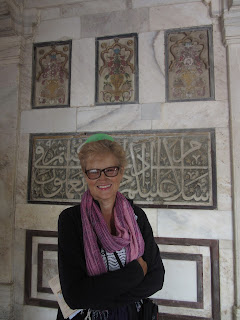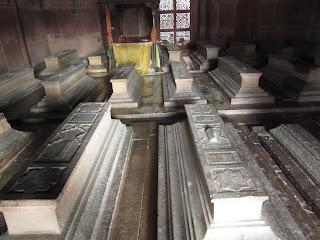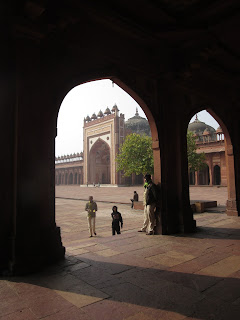Raju, the same tuk tuk driver we had hired yesterday, picked
us and our duffle bags and backpacks up at our hotel at 8:15 for the 25 mile journey to Fatepuhr Sikri. The
cost was 1100 INR – about $17 – for the half day trip which included his
dropping off at the bus station back in Agra so we could catch the bus to Jaipur.
What a very chilly ride it was in the open and packed tuk tuk - thank goodness
we had taken out our hats and gloves as we sure needed both.
Photos en route to Fatepuhr Sikri:
We saw donkeys and goats galore on the way!
Cow patties used for cooking.
Our driver said that marijuana plants regularly grow in the
ditch between the roads.
We could count on one hand the
number of taxis we’d seen in Agra . I mentioned to our driver the problem we had had on arrival
at the Agra airport and finding not one taxi or tuk tuk waiting to pick
up arriving passengers. He explained that the airport was mostly a military
base and, because of the ISIL/ISIS situation, the army forbade taxis to just
sit and wait there for incoming passengers.
Babu, our great tuk tuk driver in Agra.
When we arrived at Fatepuhr Sikri at 9:30 , the young boy above approached us as soon as we got out of
the tuk tuk. Speaking very good French before switching to English, he asked me
how I was, saying of course he wasn’t a guide but a student, etc, etc! We said
thanks but no thanks for what was in fact his offer of guide services.
Our driver wasn’t able to take us to the entrance so we
hired another tuk tuk driver for 50INR - .75 – to drive us the kilometer closer
as we didn’t want to waste valuable time walking then.
Photos of Fatepuhr Sikri:
At the entrance, another fellow, i.e. who also wanted to be
our guide, told us there were two ways up: the short and long way. We took the
long way which meant climbing up 52 rather steep steps.
Fatepuhr Sikri is a UNESCO World Heritage Site built
by the Mughul Emperor Akbar who shifted his residence and court from
Agra to Sikri for 13 years from 1572-1585 to honor the Sufi Saint Sheik Salim
Chisti who lived nearby. Son-less Akbar had gone to Sikri seeking blessings of
the Muslim saint. When his son, Salim, was born in 1569, Akbar, in gratitude,
constructed his capital city and named it Fatepuhr Sikri. Later though, due to
the shortage of water and unrest in the northwest region, Akbar was forced to
abandon the city.
Looked like Easter bonnets for sale that I used to wear as a
child!
Shortly after entering the Jama Masjid or Friday Mosque - so
called because most Muslims attend services on Fridays at a mosque - Steven
made arrangements with a man who said he was not a private guide but employed
by the mosque to give tours. I was quite skeptical or jaded that he would not
hit us up for his guide services at the end of his tour as that was what we had
come to expect based on our generally unpleasant experiences with guides in Nepal .
Abdul turned out to be a very informative guide so I was glad Steven had
agreed to have him show us around. Plus he was endlessly patient while I took
photos so how could I ever complain!
Abdul explained that in Fatepuhr Sikri, men were buried
outside the tomb above and women were buried inside. The white marble came from the nearby state of Rajastan and
the red sandstone originated from the state of Uttar Pradesh or UP.
The red strings that were strung
through the grating above indicated hopes made by devout followers, Abdul told
us.
We needed to wear hats inside the tomb so they had what looked like green, plastic, mesh small buckets for people to wear who didn't have their own. That was the first time I remember ever wearing a plastic thing on my head!
Mother-of-pearl
inlay - just spectacular as you can imagine.
The tomb's supporting posts were purposely built to be hollow so that they could collect rainwater.
There was no post
office way back when so the tiny tomb above belonged to the carrier pigeon!
Abdul told us the 5 tenets or principles of Islam are praying daily 5
times, observing the holy month of Ramadan, believing in the teachings, extending
charity to those in need, and making a haj or pilgrimage by traveling
one day to Mecca in Saudi Arabia if it is financially possible. He explained
that 20% of India ’s
population is Muslim.
Entrance to the 450 year old women’s tomb – the door was made from
sandstone.
The underground tunnel above was
built to connect Fatepuhr Sikri to Agra .
Abdul told us the Mosque was built to
resemble the Grand Mosque in Mecca and that the 5 pillars atop of the mosque represented
the 5 pillars of Islam. Ladies’ Gate: The king had 3 wives, one each who was
Hindu, Muslim and Christian – he sure had his bases covered, didn’t he?!
Blue paint, white marble and red sandstone.
While the dome represented the Muslim faith, there were also
Christian as well as Hindu arches as Emperor Akbar liked all religions, Abdul explained.
Oil lamps on top of classrooms that adjoined the mosque.
The 6 pointed star represented the Hindu religion.
Lots of pigeons!
Donations for the poor that had been collected at the mosque, Abdul explained.
Abdul then just ‘happened’ to stop at an area where he had set up items for sale! This was of course after he had initially told us he was a guide who just wanted to show us his mosque and that there was no fee, etc. I felt
compelled to buy 2 pieces of the beautiful sandstone carvings that turn pink
when wet. I am thrilled with
the intricate carvings and have nothing but wonderful memories of our tour of
Fatepuhr Sikri with Abdul but would have like him to have said from the get go
that he had souvenirs he wanted to show us at the end of the tour.
After saying goodbye to Abdul, we walked to the nearby Jodhabai’s
Palace.
Photos from Jodhabai’s Palace:
40,000 people lived within the walls of the city during the
sixteenth century.
The Winter Palace even though winters in this part of India
only last for 2 months.
Throne room.
Above and below, Jodhabai’s Kitchen.
Above and below, the Turkish Sultan’s Home.
The Jewel House gave the appearance of a 2 story structure at a distance. Once close up, however, it was a single, vaulted chamber open from floor to roof with openings on each of the 4 sides. The structure was intended for what has been conjectured as a hall for religious speeches or for private audiences. Some consider that it may have been a hall for weighing ceremony for the emperor and princes on the Persian New Year's Day.
Treasury Kiosk also known as the Astrologer's Seat.
A Parchese board laid out in the courtyard.
I felt that we didn't get much out of our visit to Jodhabai's Palace as we had no guide or information on it and there were few signs describing the buildings and the huge complex. It was interesting walking around it but without any context, it simply seemed like a group of huge, albeit beautiful old buildings.
We took another tuk tuk back down to the parking lot where our driver, Raju, had been patiently waiting for us and also keeping an eye on our belongings in the tuk tuk for the last 2.5 hours.
Photos en route back to Agra:
We took another tuk tuk back down to the parking lot where our driver, Raju, had been patiently waiting for us and also keeping an eye on our belongings in the tuk tuk for the last 2.5 hours.
Photos en route back to Agra:
Raju told us that the signs on the truck were to remind drivers to use their horns and lights at night when passing. All the large trucks had the same signs.
Shrine in the middle of a farm.Loved the 'inner wear' sign!
We have never been in any other city or country where we saw so may men wearing hand knit vests as we did in Agra.
Saw huge numbers of band trucks - thank goodness, we didn't also hear the music blaring away!
After driving back to
Our bus ride to the city of Jaipur. We had planned to take the train between Agra and Jaipur but there were no tickets left.
Musical entertainment at the half way stop!















































































































Looks like it was a very nice, interesting day. Can hardly wait for tomorrow. Lil Red
ReplyDelete